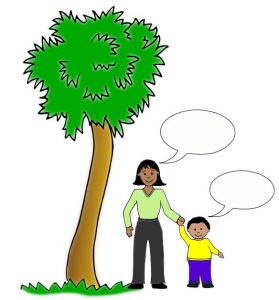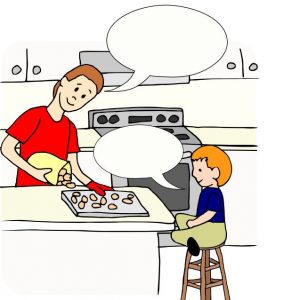 While keeping a safe physical distance from others, you can support your child’s language skills when playing outside. You can download a handout on supporting your child’s language skills when playing outside and handouts for other activities here.
While keeping a safe physical distance from others, you can support your child’s language skills when playing outside. You can download a handout on supporting your child’s language skills when playing outside and handouts for other activities here.
Page 4 of 4
 During this unprecented time of social distancing, many of us are eating at home with our families more than before. Cooking together is a wonderful way to work on language goals with your child! Narrate as you plan and cook together. This provides a language model for your child and is a great way to introduce new vocabulary and grammar. For example, “First I am mixing in the eggs, then I will mix in the milk”. Remember to speak in the first person instead of referring to yourself as Mommy/Daddy (e.g., use “I am mixing in the eggs.” instead of “Mommy is mixing in the eggs.”). Meals are also a great time to sit and practice language in a relaxed way. You can download a handout on Supporting Your Child’s Language Skills when Cooking and Sharing Meals and handouts for other activities here.
During this unprecented time of social distancing, many of us are eating at home with our families more than before. Cooking together is a wonderful way to work on language goals with your child! Narrate as you plan and cook together. This provides a language model for your child and is a great way to introduce new vocabulary and grammar. For example, “First I am mixing in the eggs, then I will mix in the milk”. Remember to speak in the first person instead of referring to yourself as Mommy/Daddy (e.g., use “I am mixing in the eggs.” instead of “Mommy is mixing in the eggs.”). Meals are also a great time to sit and practice language in a relaxed way. You can download a handout on Supporting Your Child’s Language Skills when Cooking and Sharing Meals and handouts for other activities here.
Cooking Activities and Strategies
- Before you begin, brainstorm what you want to make, and create a list (written or drawn) of the ingredients you’ll need.
- Flip through a recipe book together or look online. If your child struggles with reading, you can draw a sketch of ingredients and steps. Some food bloggers show photos not just of the finished product, but of each step of the recipe. Many children with language difficulties will appreciate having this visual support.
- Discuss the recipe together before starting. Talk about what you will do first, next, then, or last.
- Talk about where to find the ingredients and utensils needed (e.g. “The mixing bowl is in the drawer.” or “The drawer is under the microwave.”).
- Practice and talk about taking turns when adding ingredients, mixing, etc. Use phrases such as: “Whose turn is it?”, “It’s your turn now.”, “It’s your brother’s turn now”.
- Develop vocabulary by not only labeling objects (e.g., pasta, water, spoon), but also demonstrating action words (e.g., slice, pour, stir), and descriptive words (e.g., slowly, soft, sharp).
- Practice asking and answering wh-questions (e.g. “What do we need next?”, “Where is the bread?”, or “When do we add the salt?”).
- Talk about the quantities of the ingredients you’re using (e.g., “We need more carrots.”) and how they relate to each other (e.g., “This tomato is big, and this one is bigger”).
- Practice understanding and remembering directions. Some children will need short directions (e.g., “Put the lettuce in the bowl.”), and others are ready to work on longer ones (e.g., “Put the lettuce in the bowl, then go get a cucumber and wash it.”). Discuss strategies we use to help us remember and show we understand, such as repeating back what we hear, paraphrasing what we hear, or writing or drawing the information.

Welcome to the Burnaby School District Speech-Language Pathology Services website!
We hope this site will provide you with resources to support your child with his/her speech and language goals. We invite you to explore the different pages on the top of the navigation bar. Whether your child is working on their articulation skills, language skills, social skills or learning to use their augmentative/alternative devices, you will find lots of information and links to useful resources in each of those areas.
As always, please feel free to contact your child’s speech-language pathologist if you have any questions or concerns. We’re always happy to help and you can find our contact information on the “About” page.
We’re still building sections of our website so come back often for updated resources. You can also subscribe to our site so that you will be notified every time we have updates.
Thanks for stopping by!